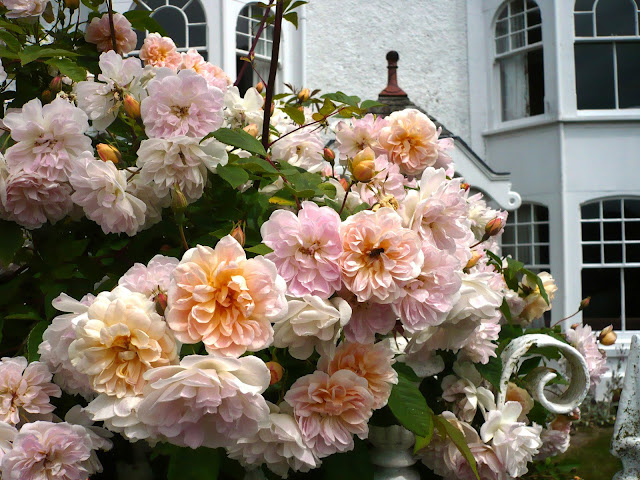The Abraham Brothers George (1870-1965) and Ashley (1876-1951) whose father ran a photography business in Keswick so it was fated that they too would follow him into photography but in ground-breaking ways for they were the first to venture onto the Lakeland crags laden with photographic gear (often weighing up to 20 lbs) climbing on ridges and ledges in all weathers to take photographs of both climbers and the views. The photograph shows them in middle age (when I imagine the cameras were a lot smaller) with their climbing accoutrements and of course the obligatory tweed suits which everyone wore to climb at the time complete with nails hammered into boots. I remember a story about them borrowing their mothers washing line (which may be apocryphal) when they tried their first climb but discovered that was far from satisfactory and moved onto more robust twine.
They made many first assents in their career as both climbers and photographers. It must be useful to have a brother's shoulder to help one make a move across a rock face.
Unfortunately unlike the
Sepia Saturday's prompt photograph of photographers taking pictures of the famous cherry blossom in Washington I have been unable to find any of the Abraham Brothers with their cameras. I know there is one because I have seen one of them in their early days with huge cameras and being amazed at the possibility of being able to climb with them. They are probably most famously associated with

Napes Needle on Great Gable in the Wasdale Valley, an important part of the early history of rock climbing in England first climbed in 1886 its iconic status is combined with the Wasdale Head Inn in the valley which is the place these early climbers gathered and so too do the modern climbers The decent of Napes Needle is considered more difficult that the climb but those people on the top are just feeling the exhilaration. The Abraham Brothers climbed this with cameras and also for the fun of just climbing it. This photograph is from "Beautiful Lakeland" published in 1912, one of the many of their books featuring their photographs. The book credits Ashley with the text and George with the photographs and describes this as "A very favourite climb, short but exceedingly difficult and only for those of long experience" and goes on to describe how to do it but as we all know from holiday disasters the best stories are those of adversity survived and enjoyed in retrospect so here is an extract from the book
"I recall a very unpleasant experience of my own on the Needle. It was a bitterly cold Christmas day of 1897, that a part of three of us climbed to its apex. We had no sooner arrived there than it came on to rain and as the rain fell it froze immediately on the rock; the Needle became almost like a huge inverted icicle. I essayed the decent, but the small handholds near the top were veneered with ice. It was quite impossible, so, with great difficulty, I regained my companions on the top. By this time a driving wind had sprung up and it behoved us to descend at once, or else be frozen and then blown off. It was an unpleasant dilemma, but we got out of it in the following manner. The strongest man of the party lowered first one and then the other of us, swinging round and round on the rope end like a spider at the end of its clew, until we reached the neck between the Needle and the mountain, seen in the illustration. Then the last man tied his rope round the top of the rock and came down hand over hand for about twenty feet, when off slipped the rope from the top and he came tumbling down on to us. Fortunately he retained his grasp of the rope and, as we were tied to the other end, we were able to arrest his fall before he had gone far. Beyond a severe shaking he was no worse, and this, with a bruised shoulder where his boot struck me as his body flew through the air; was all the damage sustained in our escapade".

And here is George's photo on firmer ground, an aspect that would have appeared on the Abraham's postcards and still does on modern cards, the road complete with potholes will be pretty similar too. In fact the potholes have got so bad that the council were to close the road to repair it this week, I wonder how far they got before the snow storm hit today and nature closed the roads in the Lake District. Great Gable appears as the middle mountain but the title of this book plate of "the gathering storm" put me in mind of the changeability of the Lake District weather and the time I sat on the mountain to the left, Kirk Fell, it was a beautiful summers day and we were fascinated to watch the speed the mist was rolling down the valley, over the lake until it climbed and covered all the mountains and everything disappeared around us, one of the many occasions it is good to have a compass to descend and regain the Wastdale Head Inn bar.







 )
)
























